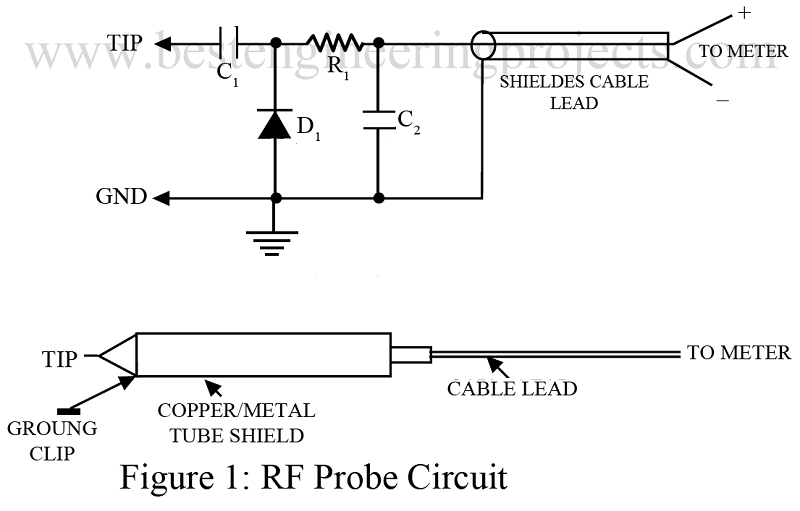In order to measure the RMS voltage between two specific points, employing heavy and bulky electronic devices sounds unusual. And, therefore a small handy instrument can be used to avoid such situations where the voltage (i.e. RMS) between two points at any distance; large or small can be determined. For this reason, the instrument RF probe circuit has been proven of great help for home users as well as for communication equipment service/design labs.
Description and Working of RF Probe Circuit
RF probe circuit is just an instrument to measure, in order to get the result of our measurement, a multi-meter must be used. With the RF probe circuit, if we intend to use a multi-meter with different input resistance, the reading noted will have multiple errors. Probably, for this reason people say, the design of RF probe circuit is a function of multi-meter we plan to use it with.
A resistance is connected in parallel with input resistance of the multi-meter such that the peak value is 1.414 times the value of RMS voltage. In the circuit, RX is that particular resistor. In order to make the multi-meter reading accurate, resistor RX has to drop some voltage. If we know the input resistance of the meter, we can calculate the value of Rx with the help of following equation:
Mathematics Involve in RF Probe Circuit
Let meter DC input resistance
X1.414=Ry
So, Rx = Ry – meter DC input resistance this concept can be more clarified with an example:
Given:
Meter input resistance = 20 MΩ,
Ry = 28.28 MΩ, and
Rx = 8.28 MΩ,
RF probe voltage reading across load resistance = 15.85 volts,
Load resistance = 50 Ω
By using following relation, we can convert the RF voltage level (E) so measured across a given load resistance (R) to RF watts (W).
Power P = E2/R watts (W)
Then, Power in given load = 15.852/50
= 5W (approx)
The conclusion is that to produce 5 watt power in a 50Ω load, the voltage across the load must be 15.85 volts.
If we observe carefully, the peak level of RF voltage at the tip of the probe is equal to the rectified DC voltage at the cathode of the diode D1 connected as in the figure. A shielded cable is used in between the output of probe and the meter such that it acts as a feed-through capacitance to avoid the RF interference. The maximum value of RF input voltage level depends on the peak inverse voltage (PIV) of diode D1. However, the shielded lead length is too large to give the accurate results at UHF. You may refer Tables I and II for ready conversion of RF voltage level (RMS) to equivalent power across a 50Ω load and deduction of value for a given meters DC input resistance respectively.
